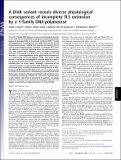A DinB variant reveals diverse physiological consequences of incomplete extension by a Y-family DNA polymerase
Author(s)
Jarosz, Daniel F.; Cohen, Susan E.; Delaney, James C.; Essigmann, John M.; Walker, Graham C.
DownloadEssigmann-2009-A Dinb Variant.pdf (1.217Mb)
PUBLISHER_POLICY
Publisher Policy
Article is made available in accordance with the publisher's policy and may be subject to US copyright law. Please refer to the publisher's site for terms of use.
Terms of use
Metadata
Show full item recordAbstract
The only Y-family DNA polymerase conserved among all domains of life, DinB and its mammalian ortholog pol κ, catalyzes proficient bypass of damaged DNA in translesion synthesis (TLS). Y-family DNA polymerases, including DinB, have been implicated in diverse biological phenomena ranging from adaptive mutagenesis in bacteria to several human cancers. Complete TLS requires dNTP insertion opposite a replication blocking lesion and subsequent extension with several dNTP additions. Here we report remarkably proficient TLS extension by DinB from Escherichia coli. We also describe a TLS DNA polymerase variant generated by mutation of an evolutionarily conserved tyrosine (Y79). This mutant DinB protein is capable of catalyzing dNTP insertion opposite a replication-blocking lesion, but cannot complete TLS, stalling three nucleotides after an N2-dG adduct. Strikingly, expression of this variant transforms a bacteriostatic DNA damaging agent into a bactericidal drug, resulting in profound toxicity even in a dinB+ background. We find that this phenomenon is not exclusively due to a futile cycle of abortive TLS followed by exonucleolytic reversal. Rather, gene products with roles in cell death and metal homeostasis modulate the toxicity of DinB(Y79L) expression. Together, these results indicate that DinB is specialized to perform remarkably proficient insertion and extension on damaged DNA, and also expose unexpected connections between TLS and cell fate.
Date issued
2009-12Department
Massachusetts Institute of Technology. Department of Biological Engineering; Massachusetts Institute of Technology. Department of Biology; Massachusetts Institute of Technology. Department of Chemistry; Whitehead Institute for Biomedical ResearchJournal
Proceedings of the National Academy of Sciences of the United States of America
Publisher
National Academy of Sciences (U.S.)
Citation
Jarosz, D. F. et al. “A DinB variant reveals diverse physiological consequences of incomplete TLS extension by a Y-family DNA polymerase.” Proceedings of the National Academy of Sciences 106 (2009): 21137-21142. ©2009 by the National Academy of Sciences.
Version: Final published version
ISSN
1091-6490